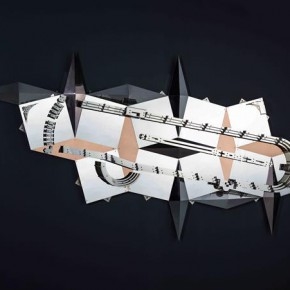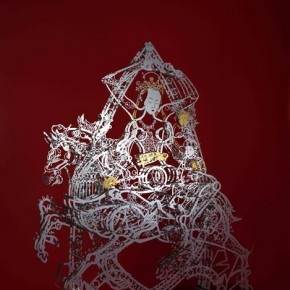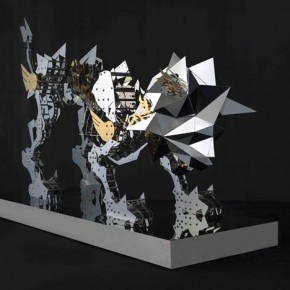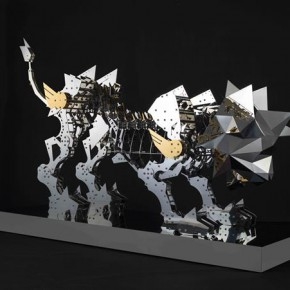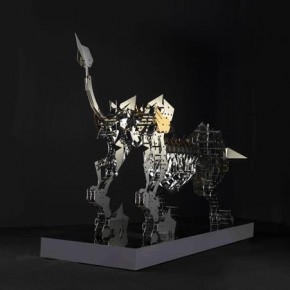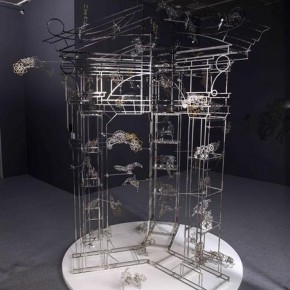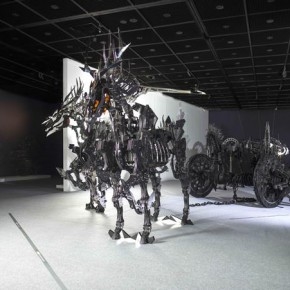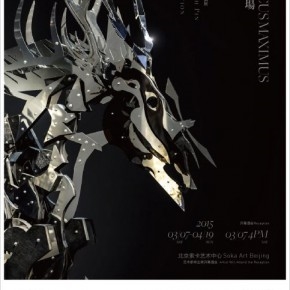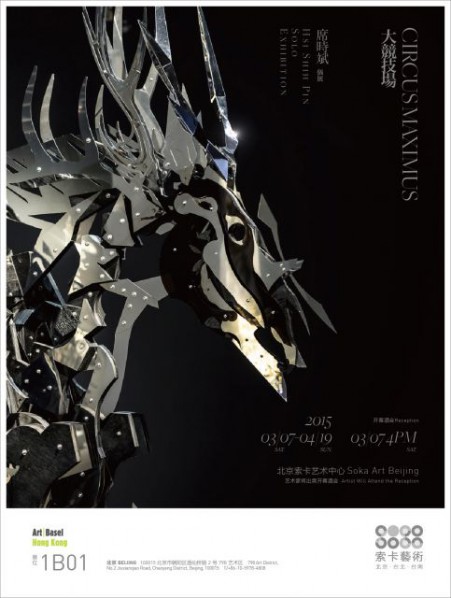
The Personal Tournament of Hsi Shih-Pin
By Menach Wong
The line consists of an infinite number of points;
the plane, of an infinite number of lines;
the volume, of an infinite number of planes;
the hypervolume, of an infinite number of Volumes.
Borges, The Book of Sand
In The Book of Sand, Borges uses an absurd narrative to construct a perfect maze, expanding the scope of literature through personal strength. If the fantasy, philosophical themes, absurdity, and repetitious language used in literature can be seen as equal to those used in visual arts, then the language used to describe literary arts can also be used to describe Hsi Shih-Pin’s current art works whose dots, lines, and planes repeatedly expand, transform, and reunite, creating a tournament in which the artist competes against himself. Hsi began his artistic endeavours with formal training in architectural design. During his studies, he turned his attention to creating art, and began experimenting with forging iron and using leftover timber for his artistic media. This eventually led him to create the stunning stainless steel works we see today. His earlier and more experimental installations were more fragmented, fluid, and uncertain, while his latter works now focus on the themes of memories and majestic palaces. Looking at them, we can see a poet working his imagination to create an aesthetic expression based on life experiences. They are the works of a mature and competent artist who can take hold of life by the reins.
Imagination and Imaginary
The challenge of sculpting lies in the representation of an idea through three dimensions. Whether abstract or objective, the artist has to rely on technique to recreate planar forms into three dimensional ones. Hsi’s sketches and blueprints reveal his prior training in architectural and spatial design as well as his affinity for Mannerism. The sketch works often feature static entities that allude to scientific and anthropomorphic themes. The recurring house theme in his sketches symbolize a chance to change past experiences. Hsi is fond of collecting medieval religious images (stories) and nature illustrations (reports), as he is attached by their narratives. Between the seams where narrative and image meet, Hsi finds a real where his imagination creates his own mysterious experience. Through a lingering gaze and with a indulging yet thoughtful mindset, he confidently creates a universe constructed out of straight lines: e.g. House #1, Horse #2: Sagittarius, Horse #3 Aldo Rossi & Leonardo da Vinci, and other works. The horse theme is close to his heart, as he spent much of his youth studying the subject. Much time, effort, materials, and good narratives were spent on perfecting “every detail of the horse,” which eluded Hsi for years. These efforts later led to the creation of the large work, Horse #5: Queen, which can be cross-referenced with Madonna with the Long Neck by Girolamo Francesco Maria Mazzola (about 1503-1540). Figures of Francesco Mazzola feature exaggerated slender features. Hsi extended this quality to imbue Queen with a bizarre adventurous quality. Yet, this queen is not a benevolent one. Featured above the neck is a compilation of horns, bats, snakes, and deformed flowers. At first sight, it appears like a classical composition. However, upon closer inspection, one finds hints of skeletons, animal bones, and other imageries related to death. It is as if time was pulled away from under the carpet, leaving behind a sterile void. Between every intersection lies a hidden narrative, each interconnected with adjacent storylines. It appears like a “dream” that went haywire. This is the microscopic world seen through the lens of an alchemist or the microcosm described by a mystic philosopher. It’s “Aleph”, the number of an all encompassing space or numerous spaces.
Intentionally obscuring his sketching and blueprint, Hsi draws from his professional training to mold polymeric smart materials in creating his artworks. Regarding the connection between imagination and dreams, Hsi made the following remarks: “Although we are describing the same thing, every word has been altered by the narrator. Regarding dreams, the narrative continuously changes and is rearranged.” He musters all energy to amass images related to his life experiences. These memories are of Taiwan’s unique flower-patterned iron window frames, the railroad tracks near his grandmother’s home, his mother’s scissors and sewing machine, the lonely times as a child when he had no one to play with, etc. Through an endless process of modification, he transforms architectural blueprints into tangible artworks that project and summarize his life memories, which repeatedly merge and reassemble to form an overarching narrative. Lines drawn in blue ink are applied to steel plates and exude a sense of infinite plasticity. Different widths create a topology of textures that represent an extension of time and a rewriting of memories. Drafting a blueprint before constructing his stainless steel works is Hsi’s way of warming up for the upcoming creative process. Compositions that express his relationship to an object start off as a dots and lines on a computer screen. Through a process of transforming, enlarging, removing, and layering, he assembles a composition that is comprehensible. By positioning these dots and lines, he creates an illusion, an image that conveys his world view. Some of the blueprints might become part of a more complete entity, while some never make it into his artworks, lingering in his computer’s storage forever. This blueprint world is an obscure one, as Hsi reiterates them from each perspective, creating numerous possibilities and rich fantastical realms.
Material and Composition
Echoing the passage, “my dreaming is your awakening (and vice versa)”, from Funes the Memorious, Hsi’s dreams are indeed of sober recollections scattered throughout the flow of time. It also reveals the fact that Hsi hails from a generation of Taiwanese artists born during the 1970s. Through a mysterious process that turns blueprint concepts into three dimensional sculptures, he spawns a type of “fake art” into reality, through which he rearranges spatial perceptibility. These are artworks underpinned by mathematical formulas, and whose many stainless steel layers dazzle viewers. Although there are no repetitive element, the works still manage to convey a sense of plurality. Complex planes come together to form a single coherent entity (sculpture). In terms of freedom in creativity and choice of material, every otherwise autonomous entity is assembled in a way to create a singular form. This is what make Hsi’s works so powerful. The source of inspiration behind the artist’s creativity stem from the call of the wild.
Looking back at Hsi’s works over the past five years, most of his creative focus has been on creating beast-like sculptures. Whether creating a horse (Gallop of the Zodiac Steed and Symbolic Steed of Memory) that symbolizes maturity, deer (Louis - The Fawn Swing) of childhood memories, or imaginary monster-like beasts (Gryphon with Phoenix Tail, Qiling, the Silver, and Polyhedron Lion), Hsi’s curiosity and passion for learning about a subject has led him to become an expert in animal anatomy as well as an avid collector of specimens. His knowledge extends beyond the scope of anatomy, as he also focuses on non-scientific and more spiritual concepts. He conceptualizes, systemizes, and standardizes concepts of modern medicine regarding “the body with organs.” Yet, he does not discern this knowledge from realizations achieved through intuition and a more spiritual internalization. This shatters our understanding about life, and marks the demise of our modern perception of the body.
Hsi’s treatment of the relationship between himself and objects of desire is very unique. His artworks are a representation of a world devoid of time. Every beast sculpture is created, frozen in a particular pose yet with a certain momentum. He transforms memories into something liquid. And, sealed within this fluid steam we call time are the beasts, each frozen in time. Skew and steel layers form knots in The Gate of Animals to create a structure revealing a purist construction. Within this realm of repetitive misplacement, the artist creates an iconic and discrete effect. This is an internal space, which stems from fantasy and is purely subjective in nature. Perhaps it can be said that Hsi is attempting to create art that does not belong to the field of sculpture. With its complex composition and shiny luster, Polyhedron Lion is a work that accentuates the relationship between what can and cannot be seen. The artist reveals the internals of the beast, and unravels the mystery of light. In a bold fashion, stainless steel is intertwined into a decorative installation art.
Tournament and Shadow
Just like in a video game, Hsi enters a new stage after exiting the his memory palace. Now, he faces the uncertainty of having to compete in an even grander arena. After the blueprints phase comes the stage for laser cutting and assembly. Hsi has often said: “Actually I don’t know how the final work will look like.” Although every component is designed with the utmost precision, the final result is always somewhat “shadow.” To bring this elusive concept into the real world is a lonesome journey the artist has to take. This elusiveness often alludes to the notion of a “field,” which is later expressed in the completed work. It is a powerful and dense field that is all encompassing. Like a caterpillar wrapping itself in a cocoon to morph into a moth, it will soon reach the end of its life. Looking at the final assembly of the work, it is evident that Hsi is seeking to fulfill an extreme experience. By immersing himself in artistic practices and learning through experience, sculpting has provided Hsi with a method to interpret a world of negative space and sharp edges. Each piece has the potential to branch into its own series (from the Horse to Carriage series to an amalgamation of themes). Through assembly of seemingly unrelated components, the artist is able to construct an alternative world. When viewing Hsi’s works, one mustn’t overlook the importance of shadows and lighting effects. The achievement of these physical attributes is the result of thoughtful planning. Unlike in museology, the placement of items dictate their relationship with other items. The Holy Mother is a work based on the “human” figure, and features angels surrounding Virgin Mary holding her child (à droite: la Vierge et l'Enfant, Jean Fouquet, 1420-1481). Yet, the figure is seated in a lotus position like the four-armed Lakshmi of Tibetan Buddhism. The figure is riding on a three donkey heads, while her head is turned to one side. Extending from the back and surrounding the figure is an olive shaped halo that is cover in flower patterns. Aside from its aesthetic beauty of its form, light shown on this piece give it qualities similar to those of paper crafts. Fragments of lifeless stainless steel are assembled together to create a unique sculpture. By treating space as planes that are layered on top of each other, the black form of a benevolent mother is created. This work offers a hint of what is to come from Hsi in the future. It fully conveys his feelings of nostalgia and memories of his mother. The notion of museology mentioned previously refers to an attitude when attaining knowledge and interpreting events around us. Function and morphology are what are needed to discern between events and items. Hsi’s Holy Mother embodies a concept that has long been close to his heart. It is only now that he is acting on his urge to manifest this “shadow” concept into reality. So, what has eluded Hsi in his life? To answer this, we can take the perspective used in Reality and Its Shadow by Lévinas. By removing the decorative element of Holy Mother, we gain a fuller understanding of the artwork (similar to the flower patterns in memories) and artist himself. It reveals something personal about the artist. The work echoes a sense of exoticism. The olive-shaped decorations (female genitals) provide a hint of Shakti’s powers to give birth to the universe and life (mother). Juxtaposed against the pristine image of the Holy Mother, this creates a contrast that alludes to the duality of blissfulness and disaster. From no angle does this work convey unsettling sensations because its interpretation is based sheerly on the viewers themselves. It is a work that transcends cultural preconceptions and which viewers find themselves lost within the many emotions it elicits. This work simply exists, and no words can describe it.
Circus Maximus at Soka Art Center Beijing is the first large scale exhibition Hsi has held in Beijing. It is a bold and magnificent display of works created by a young, up-and-coming Taiwanese sculptor. Drawing from his architectural training, Hsi created a perfect interpretation of the ruins of the Roman Colosseum. The work, Circus Maximus, is a compilation of geometric spatial models that feature angular and shiny surfaces. On display are concept Blueprints and individual components, which are arranged on walls to create a relief-like artwork. Renowned works, such as Symbolic Steed of Memory, Holy Mother, Polyhedron Lion, and The Gate of Animals will also be showcased. Also present at this exhibition is Hsi’s largest and most impressive piece, Plato's Carriage of Soul. With this mix of works, the artist aims to convey both physical and spiritual concepts. Circus Maximus is an extension of the artist’s desires. Every piece of stainless steel is its own microcosm, a slice of space, a dilation of time. They are each a world that encapsulate Hsi’s inner self, and represent a Leibnizian take on Mannerism. Hsi uses equal expression to express his microcosm. By manipulating the motion at an atomic and microscopic level, he puts his creative prowess to practice. Manifesting his memories into gigantic, physical artistic forms, Circus Maximus showcases Hsi’s wisdom and skill. This is an arena in which Hsi competes against himself in a prelude to his next artistic endeavour, and serves as a manifestation of his tireless urge to understand forms.
About the exhibition
Dates: 2015-03-07—04-19
Venue: Soka Art Center
Courtesy of the artist and Soka Art Center.



